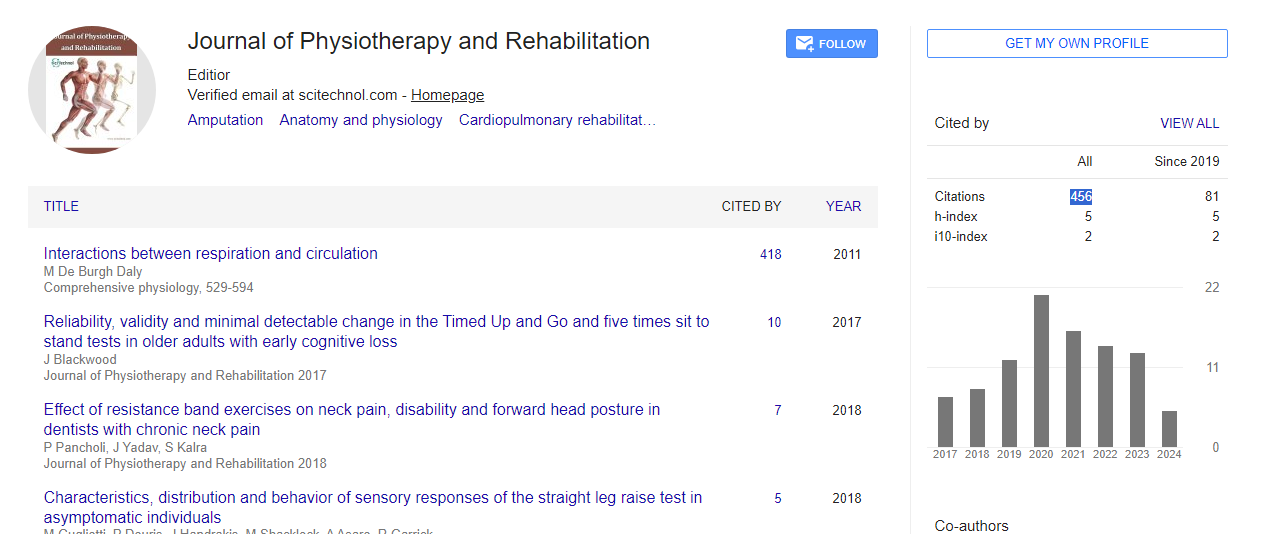Perspective, J Physiother Rehabi Vol: 8 Issue: 4
Rehabilitation through the Lens of Bio-Mechanisms: New Therapeutic Approaches
Raged Malid*
1Department of Physical Therapy, Prince Sattam Bin Abdulaziz University, Al-Kharj, Saudi Arabia
*Corresponding Author: Raged Malid,
Department of Physical Therapy,
Prince Sattam Bin Abdulaziz University, Al-Kharj, Saudi Arabia
E-mail: malidra@ged.edu.sa
Received date: 23 July, 2024, Manuscript No. JPTR-24-147321
Editor assigned date: 25 July, 2024, PreQC No. JPTR-24-147321 (PQ);
Reviewed date: 08 August, 2024, QC No. JPTR-24-147321
Revised date: 15 August, 2024, Manuscript No. JPTR-24-147321 (R);
Published date: 22 August 2024, DOI: 10.4172/JPTR.1000177.
Citation: Malid R (2024) Rehabilitation through the Lens of Bio-Mechanisms: New Therapeutic Approaches. J Physiother Rehabi 8:4.
Description
Rehabilitation science has undergone significant evolution over the past few decades, transitioning from purely physical therapies to an integrative approach that encompasses the biological mechanisms driving recovery. Understanding bio-mechanisms at the cellular, molecular and systemic levels has opened new developments in therapeutic approaches, making rehabilitation more effective and personalized. The foundation of effective rehabilitation lies in the body's natural ability to heal, a process governed by a complex network of cellular and molecular interactions. Following an injury, the body initiates a series of well coordinate responses beginning with inflammation, followed by tissue repair and remodeling. Key players in this process include cytokines, growth factors and stem cells which regulate inflammation promote tissue repair and facilitate the regeneration of damaged structures. The role of Mesenchymal Stem Cells (MSCs) in rehabilitation has collected considerable attention. These multipotent cells can differentiate into various cell types including bone, cartilage and muscle cells making them a promising tool in regenerative medicine. Therapies involving MSCs have shown potential in treating musculoskeletal injuries by enhancing tissue repair and reducing inflammation.
Neuroplasticity the brain's ability to reorganize itself by forming new neural connections is important in bio-mechanism in the rehabilitation of neurological injuries. This process is especially important for patients recovering from strokes, traumatic brain injuries or spinal cord injuries. However, recent advancements have significantly expanded the toolkit available for promote neural recovery. Mechanotransduction, the process by which cells convert mechanical stimuli into biochemical signals plays an essential role in tissue remodeling during rehabilitation. This bio-mechanism is particularly relevant in the rehabilitation of musculoskeletal injuries where mechanical loading can influence tissue repair and adaptation. Progressive Resistance Training (PRT) is a widely used rehabilitation technique that advantage mechanotransduction to promote muscle hypertrophy and strength. By gradually increasing the resistance during exercises, PRT induces mechanical stress on muscles leading to cellular responses that enhance muscle fiber size and strength. Similarly, specialized stretching exercises can influence the biomechanical properties of tendons and ligaments improving flexibility and reducing the risk of re-injury. The future of rehabilitation lies in the integration of bio-mechanisms with emerging technologies and therapies. One promising area is the use of biofeedback devices that monitor physiological parameters such as heart rate, muscle activity and neural signals in real-time. These devices can provide immediate feedback to patients and therapists enabling the adjustment of therapeutic interventions to maximize effectiveness. Moreover, advances in biomaterials and tissue engineering are lead the way for novel rehabilitation strategies.
Conclusion
Rehabilitation through the lens of bio-mechanisms represents a ideal shift in how we approach recovery from injury or illness. By understanding and manipulating the body's natural healing processes clinicians can design more effective personalized rehabilitation strategies. As research continues to disclose the complexity of biomechanisms, the integration of these insights with innovative technologies will undoubtedly lead to new developments in therapeutic approaches offering hope for better recovery outcomes and improved quality of life for patients worldwide.
 Spanish
Spanish  Chinese
Chinese  Russian
Russian  German
German  French
French  Japanese
Japanese  Portuguese
Portuguese  Hindi
Hindi 